From The CRPG Addict
- Returned to Teotihuacan with the fire opal and received from the medicine woman the second magic word for the “Mind” college. (There is no first word; all mind spells start on the second level.)
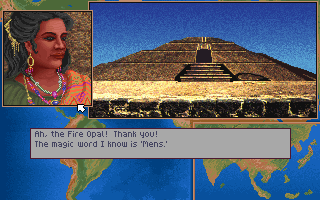 |
| Great. I can now go to the restroom. |
- Used this new word to create the “Dispel” spell
- Visited new locations available on Earth, bought more reagents. Got a quest from Dr. Chen Xiong at Great Serpent Mound, Ohio, to get a Scroll of Thoth. Got a quest from Ali ibn Mustaph in Giza to find the Plaque of Quetzacoatl, for which he promised the Scroll of Thoth.
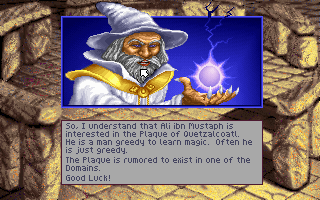 |
| Garwayen disses my new NPC friend. |
- Explored the Earth Domain again. Found the Plaque of Quetzacoatl.
- Took the Plaque to Ali. Got the Scroll. Took the Scroll to Chen and got $15,000. Took a copy of the Scroll to the medicine woman in Teotihuacan who told me it was a fake and that the real one was in the Fire Domain.
- Explored the Air and Fire Domains and killed their respective wizard simulacra created by Garwayen. Found the real Plaque in the Fire Domain. Returned to the medicine woman, who translated it. This got me the first-level magic words of all the elemental domains.
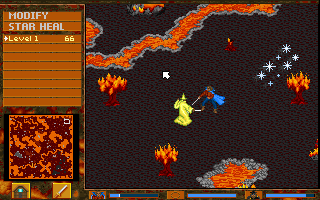 |
| Fighting the Fire Wizard simulacrum in a rare moment with no other enemies around. |
- Defeated the simulacrum in the Air Domain and was rewarded with the Scarab of Nefertiti, an equippable item that increases combat damage.
- Visited the hippie at Stonehenge and got a Hauberk of Safety.
- Created first-level attack spells: “Ice Arrows,” “Magic Sword,” and “Lightning Bolt,” plus the non-attack spell “Cure Poison” and the conjuration spell “Create Orc.”
- Cleared the Air, Earth, and Fire Domains of a ton of enemies using my new spells.
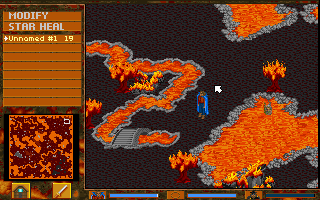 |
| Just wanted to point out this completely useless bridge in the Fire Domain. |
- Committed suicide to visit the Death Domain and find the second-level magic word for water spells.
- Created “Water Breath.”
- Used “Water Breath” to explore the Water Domain and defeat a wizard simulacrum, found the second level fire magic word, the Cap of Defense, and several new spell recipes.
- Defeated four more simulacra in each of the domains.
 |
| Do you suppose he says this all the time? Because my spellcasting was pretty clumsy and wasteful. |
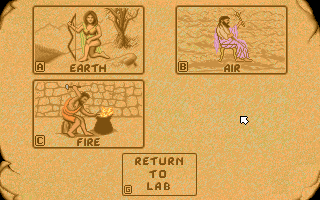 |
| Occasionally, you have a choice as to the order in which you visit domains. |
 |
| Killed by a combination of summoned creatures. |
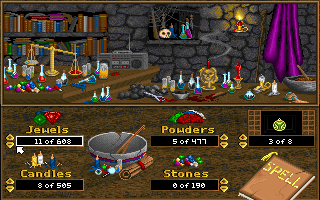 |
| Mixing “Water Breath.” |
Each time you enter a domain, there are fixed numbers of monsters to fight, regular chests to find, and special chests to find. (Special chests usually contain quest objects.) Once you get all those down to 0, you’ve “cleared” the domain for the time being. Pixels flash on the automap to show where remaining monsters and chests are, but some of them are awfully small and hard to see. (These have been automatic so far, but something Garwayen in my last mission makes me think I’m going to need to learn spells for them from now on.) For the first time, I find myself playing a lot in enlarged or full-screen mode. When you kill the last monster, the character jumps up and down for joy a few times.
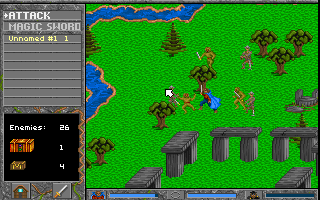 |
| The level information screen shows that I have a lot of enemies to go. |
 |
| Fighting a revenant in the Death Domain. |
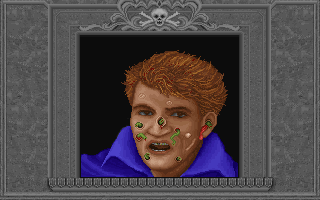 |
| This is why you wear protection, kids. |
 |
| Continuing to fill in the spellbook. |
- Stonehenge, where I meet a hippie named David.
- Salem, where I meet a museum tour guide named Selina who seems to be into me.
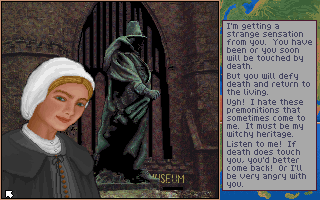 |
| The cost of transatlantic flights is getting prohibitive. Maybe you could come visit me once? |
- Great Serpent Mount, Ohio, where a professor named Chen Xiong is interested in magic maps. I honestly didn’t know anything about this location before playing this game, it being in Ohio. It’s just a mound of dirt piled into the shape of a serpent about 1,400 feet long, but it’s been around for 2,400 years. That’s the kind of thing that gives me chills. A bunch of earth, shoveled into a pile, will outlast all your dreams and will still stand when your descendants have forgotten your name.
- Dinosaur Provincial Park, Alberta, where I meet a paleontologist named Jack Hendricks. He sells stones, which I’m always running out of because of healing spells. I can’t imagine anything mystical about this park except the suggestion from the manual that the dinosaurs may have used magic.
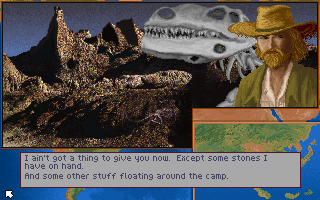 |
| Do Canadians use “ain’t”? I’m not sure I’ve ever heard it from one. |
- Teotihuacan, Mexico, which is often described as an “Aztec” ruin but was actually already in ruins before the Aztec civilization arose. There, a medicine woman–who has just now given her name as Senora Espirita (I suspect it’s a pseudonym)–has helped me already on several occasions. Just now, she gave me another spell formula.
- Machu Picchu, Peru. Here at this Incan site, I incongruously meet a Navajo Indian who tells me that the spirits have a present for me, but I must first give them a present: a feather from the Air Domain.
 |
| If I can meet a Chinese man in Ohio and an Englishman in Italy, why not a Navajo in Peru? |
- Mount Fuji, Japan, where I meet a geisha named Lotus Flower, which probably has nothing to do with the film Teahouse of the August Moon (1956), but everyone should go watch it immediately anyway.
- Giza, Egypt. My contact, Ali ibn Mustaph, just sold me a tablet for $1,000 that has more spell formulas. Or, at least, he sold me the promise of a tablet. He seems a bit of a con man, so I may have just wasted that money.
- Transylvania, Romania, where I meet a woman named Natalye, another tour guide, this time at the castle of Vlad the Impaler. She doesn’t seem to believe in magic, but she does sell some reagents.
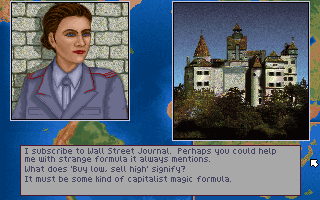 |
| We’re only a few years past the Romanian Revolution here. |
- Pompeii, Italy, where my contact, an English tourist, just gave me a magic formula that has something to do with “solidifying Neptune’s realm.”
It’s getting pretty expensive to do this circuit, but everyone almost always has something new to say or offer every time I visit.
- “Boil Blood”: Decent offensive spell that often kills enemies outright.
- “Cure Poison”: Vital when needed. No power levels; it’s a binary spell.
- “Dispel”: Dispels enemy spells. Theoretically. I can’t quite figure out the rules of when it works and when it doesn’t.
- “Dragon Flame”: Sounds awesome, but it’s basically “Lightning Bolt” with fire and doesn’t do as much damage was you would think given the component cost.
- “Fire Barrier”: Creates a barrier of fire that damages anyone who moves through it. Seems tough to guarantee that anyone will move through it, and it’s tough to target during the chaos of combat. I could see where it might be useful to “box in” an enemy.
- “Fireball”: Very difficult to target. Technically, it hits not the enemy you point it at, but rather “seeks out the most threatening enemy.” Theoretically, you can cast these in any direction from a fixed starting point, and they’ll wander around until they find someone worth hitting. Functionally, they often hit an object or a less-threatening enemy first. I get hit with them a lot but don’t get a lot of use out of them myself.
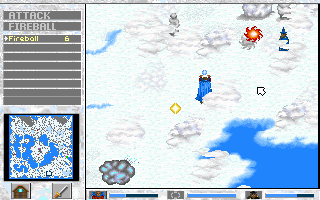 |
| My fireball angles towards an Air Wizard. |
- “Ice Arrows”: I think this one is bugged. It’s supposed to send out “a series of arrows” that, like “Fireball,” seeks the most difficult enemies. In practice, it often sends out one arrow that then just sits there on the map.
- “Lightning”: The only Level 1 offensive spell that you can directly target. Unfortunately, it seems weak. It never kills anyone.
- “Magic Sword”: Pretty awesome. It creates a magic blade that goes after the nearest creature and fights until one of them is dead. Great for occupying one enemy while you fight another.
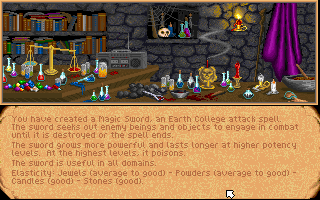 |
| Apparently, if I can get this to a higher level, it will poison enemies. |
- “Orc”: A creation spell that summons a weak orc. Not quite as good as “Magic Sword,” but there doesn’t seem to be any limit to the number you can conjure, which is helpful when dealing with a wizard and the minions immediately around him.
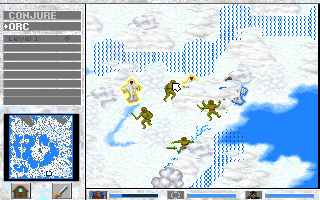 |
| My summoned orcs aren’t doing very well against a couple of ghosts. |
- “Star Healing”: Absolutely essential. Makes up a lot for poor skill or planning in other spells.
- “Steam Vapor”: Creates a hot mist cloud that roams around and scalds enemies. I like the idea, but in practice I guess I prefer spells that directly target specific enemies.
 |
| Formulas are often provided after solving quests. |
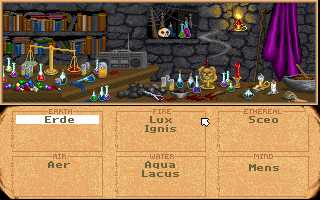 |
| Now that I know IGNIS, I can upgrade all the spells that originally used LUX. |
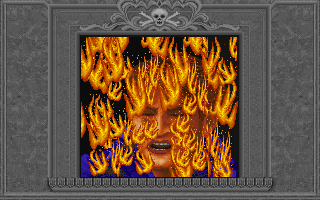 |
| Another mixture goes badly. |
Time so far: 10 hours
Original URL: http://crpgaddict.blogspot.com/2019/08/spellcraft-long-apprenticeship.html

